Uncategorised
Artists in Residence
Artist in Residence, The Old School Mt Wilson
beauty, diversity, tranquility
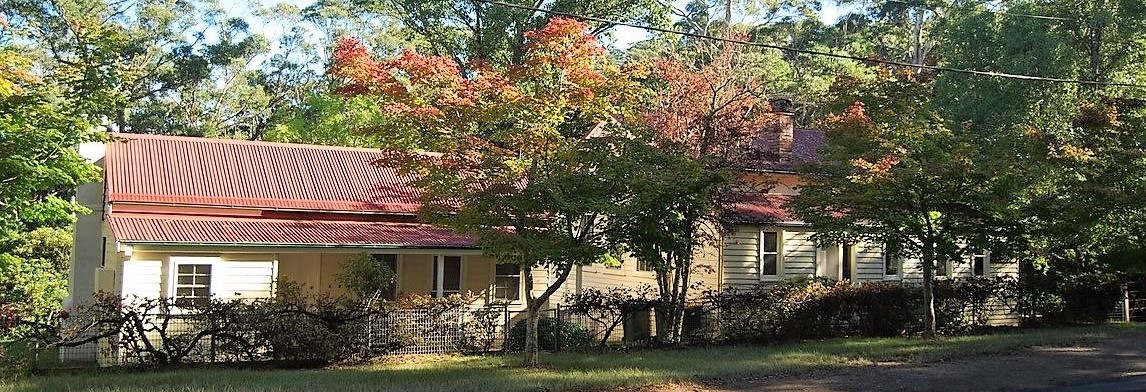 The Old School, Mount Wilson commenced an Artist in Residence program in 2019. This is a volunteer based, not for profit organisation aiming to share the beauty, diversity and tranquility of Mount Wilson, providing an opportunity for artists to work, be supported by and engage with the local community.
The Old School, Mount Wilson commenced an Artist in Residence program in 2019. This is a volunteer based, not for profit organisation aiming to share the beauty, diversity and tranquility of Mount Wilson, providing an opportunity for artists to work, be supported by and engage with the local community.
The program provides residency, accommodation and studio, for one month for both emerging and established artists and suits musicians/composers, writers, visual and textile artists.
Each resident will give a community engagement event.
![]() Artist in Residence on Facebook
Artist in Residence on Facebook
![]()
Artist in Residence on Instagram
Applications are now closed for the October 2024 to June 2025 period
There is no residency offered for April
All applicants will receive their result by the end of July

|
For more information or to be added to our email list, please contact This email address is being protected from spambots. You need JavaScript enabled to view it.
The Old School Mt Wilson gratefully acknowledges the commitment and generosity of our supporters.
Anne de Salis & Martin Barge
Nancy Fox AM & Bruce Arnold
Steve Gracie
Griffin Foundation
Mary Holt OAM
Joe & Elizabeth Montano
Anon (1)
Please consider making a donation towards the future of the Artists in Residence program at The Old School. Your gift, of any size, is a vital contribution to the program’s future.
All gifts over $2 are fully tax-deductible.
To support The Old School Artists in Residence program, you can:
- Make a direct deposit to:
- Account name: The Old School Mt Wilson Public Fund
- BSB: 082-678
- Account: 31 143 7891
- Email: This email address is being protected from spambots. You need JavaScript enabled to view it.
Please include your name in the description to receive your tax-deductible receipt.
Residencies for November 2023 to June 2024
Ward O'Neill
Johanna Hildebrandt
Frankie Dyson Reilly
Anna Spencer
Peter McLean
Frankie Meaden
Residencies for November 2022 to June 2023
Belle Bregovic emerging poet/classical pianist and guitarist Eitan Muir during their residency will delve deep into their craft and develop new performance works, culminating in a premier performancefor the Mt Wilson local community
Helen Pitt is a senior writer at the Sydney Morning heraldand author of The House, the extraordinary story of the Sydney opera House and the people who built it. This residency will be her first attempt at writing fiction, working on an idea about French female explorers in NSW
Helen Begley is a song writer, composer, performer, teacher and facilitator, currently working on a trilogyof musical performance pieces that explore the stories of femaile immigration to Australia in the 1930s, "Voyage", "Wild" and "Wrecked". During her residency she will be working on "Wild" , the story of immigrant Martha Wild.
Sharon Peoples is a textile artist oscillating between hand and machine embroidery to examine issues. She is energised and draws inspiration from gardens. For her residency she proposes to take time to researchand explore the birds that are present or migrate through the Mt Wilson 'garden'
Anna Glynn artist and Peter Dalmazzo biologist will explore the Blue Mountains basalt forest endangered ecological community creating artwork to focus attention and highlight a stunning and complex environment
Marynes Avila is a multi-award winning artist concerned with socially engaged practice who creates work that specifically responds to site and community
Read the artist statements.......
Residencies for November 2021 to May 2022
Cadance Bell is an author, writer, producer and director.
Brad Gill is a musician and composer
Ariella Van Luyn is a writer
Natasha Dubler is a multidisciplinary artist working across sound installation, music performance and small sculpture.
Anna Glynn artist & Peter Dalmazzo biologist
Jennifer Keeler-Milne is a visual artist.
Read the artist statements here
Residencies for October 2020 to June 2021
Jane Guthleben is a visual artist whose practice involves a fascination with C17th Dutch still life paintings and how to reimagine them in an Australian context
Jody Graham is a multidiscipline artist, whose artwork commemorates loss and memory. Her purpose is to conserve valuable stories and contribute creatively to the Australian bushfire history.
Leah Bullen is a visual artist whose practice explores various locations that recreate and curate the natural world, such as gardens.
Julie Thorndyke is a writer
Read the artists statements......
Residencies for October 2019 to May 2020
LeAnne Vincent a photo based visual artist read more.....
Leisel Mott is a landscape painter
Tristan Coelho composer and Emily Granger harpist
Troth - Amelia Besseney and Cooper Bowman together they fashion ethereal soundscapes from field recordings, vocals, electronics, zither, tape loops and sampled percussion and piano
Mandy Beaumont is a novelist
Lynne Ainsworth will be working on her memoir 'Someone Must Pay'
Read the artists statements......



White Jasmine (Jasminum polyanthum)
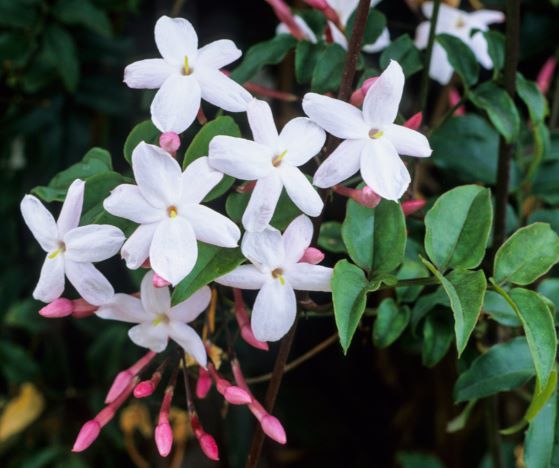 Jasmine provides a very scented and pretty creeper but this needs to be controlled as Jasmine is a serious weed in the Rainforest.
Jasmine provides a very scented and pretty creeper but this needs to be controlled as Jasmine is a serious weed in the Rainforest.
Type of weed: Climber, scrambler or groundcover
Flowering Months: September, October, November
Native of China. A fast growing evergreen climber with small shiny green leaves and white flowers which are pink in bud and sweetly scented. Jasmine spreads by self-layering and occasional setting of seed. It can seriously threaten the rainforest edges of Mt Wilson. This plant has become a big problem in some gardens.
Alert: The flowers can cause allergies in some people.
Don’t confuse with… Jasmine can be confused with native Wonga Wonga Vine (Pandorea pandorana) before the plant develops the distinctive lobed leaves and before it flowers.
Impact on bushland
Jasmine climbs rapidly into the tree canopy and covers vegetation at all levels, blocking light and restricting the growth and regeneration of native species. Its weight may bring down branches. It is a serious weed of rainforests.
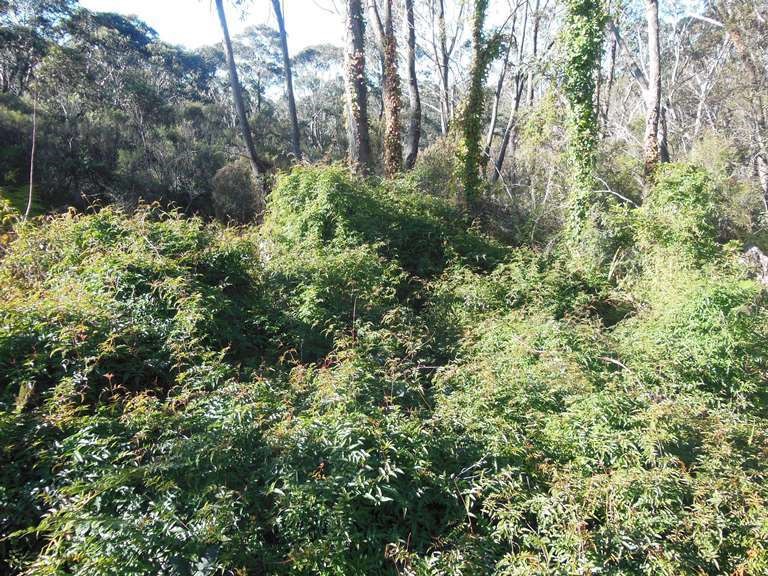
Prevention
- Keep well pruned
Control
Because of the fine twining stems and vigorous nature of this plant it is hard to eradicate.
- Dig out or spray December to March.
- Scrape and paint stems.
- If the vine has grown up into the canopy of a tree or shrub, cut each of the vine stems about 500 mm above the ground, after scraping and painting above and below the planned cut, to allow the parts in the tree canopy to die. It is important to keep the cut low to allow adequate length of the stems to be reached for re-treatment.
Alternative native plantings
- Twining Purple Pea (Hardenbergia violacea)
- Wonga Wonga Vine (Pandorea pandorana)
- Water Vine (Cissus antarctica)
- Old Man’s Beard (Clematis aristata) - note: not Clematis cultivars as these can also be environmental weeds.
Himalayan Honeysuckle (Leycesteria formosa)
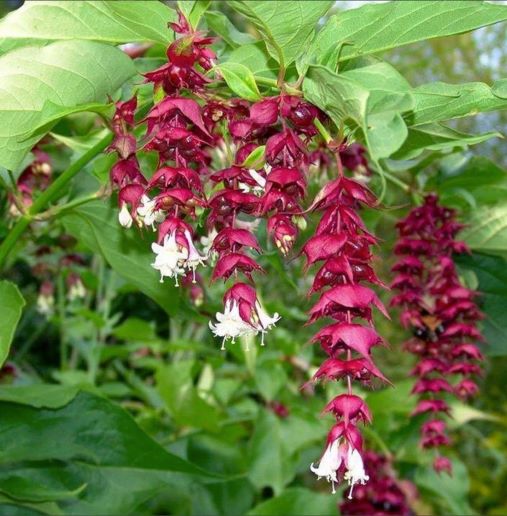 Himalayan Honeysuckle invades sensitive moist bushland such as Blue Mountains swamps where it forms thickets and dense shade, displacing native vegetation.
Himalayan Honeysuckle invades sensitive moist bushland such as Blue Mountains swamps where it forms thickets and dense shade, displacing native vegetation.
A deciduous multi-stemmed shrub to 3 m high. Stems are erect, hollow and bamboo-like. A native of the Himalayas. Leycesteria is a vigorous arching shrub with large, soft green leaves and drooping panicles of white flowers which are followed by clusters of shining dark purple berries spread in December and January by the birds. These plants grow well in the semi-shade of the rainforest.
Fruits are ovoid fleshy berries, dark crimson when ripe. Each fruit contains more than 100 small seeds.
Control
- The plant should be fully and continuously suppressed and destroyed
- Dig out, or cut off and poison every stem.
- Spray large areas November to March.
Japanese Honeysuckle (Lonicera japonica)
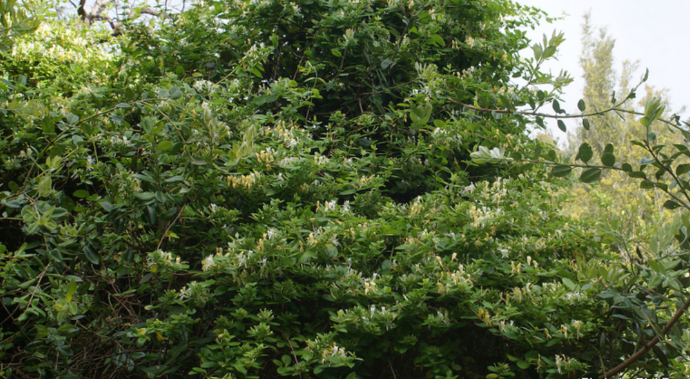 A native of China and Japan. Japanese Honeysuckle is a vigorous climber with soft green leaves and pale yellow, sweetly scented flowers which self layers and quickly grows up and over shrubs and small trees, smothering them. The black berries are carried by the birds.
A native of China and Japan. Japanese Honeysuckle is a vigorous climber with soft green leaves and pale yellow, sweetly scented flowers which self layers and quickly grows up and over shrubs and small trees, smothering them. The black berries are carried by the birds.
Japanese Honeysuckle is a vigorous, fast growing scrambling and climbing shrub with distinctive pinkish new stems. Old stems can become thick and gnarly.
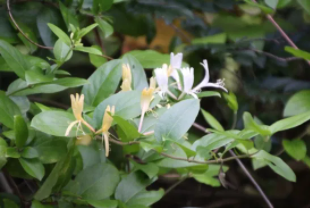
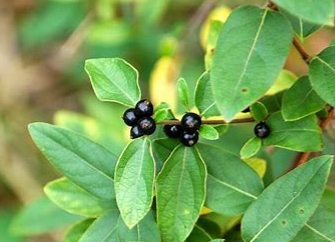 Spring is a good time to identify Japanese Honeysuckle, a creeper with its distinctive small yellow cream to white flowers with a pink tube. Flowers occur in pairs and mostly in spring to autumn. Flowers are fragrant and nectar-filled.
Spring is a good time to identify Japanese Honeysuckle, a creeper with its distinctive small yellow cream to white flowers with a pink tube. Flowers occur in pairs and mostly in spring to autumn. Flowers are fragrant and nectar-filled.
Small shiny black berries 6–10 mm long occur in autumn.
Impact on bushland
Japanese Honeysuckle grows rapidly and forms a dense shade over shrubs and low canopy trees, blocking the light, breaking branches and causing loss of biodiversity.
Control
Japanese Honeysuckle twines in and around other plants, making it difficult to control.
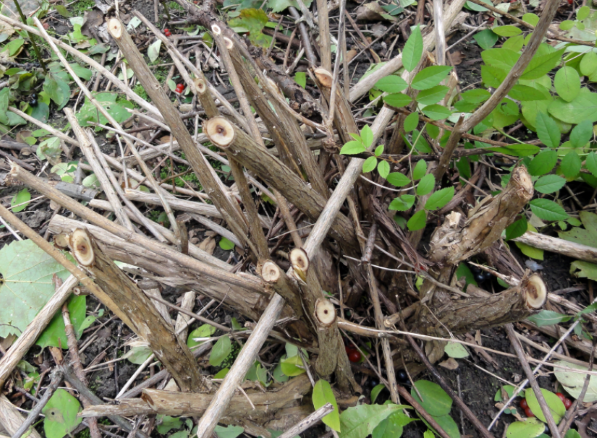
Vines climbing up shrubs or trees:
- Scrape each stem as far as possible and paint; suspended vines can then be cut and left in place.
- Suspended vines are easily identified as they look like gnarly paperbark vines.
- Cut and paint large crowns and scrape and paint as many roots as possible.
Vines growing on the ground:
- Pull out by hand, making sure all root and stem parts are removed. Cut material can be spread out off the ground. Once dead, it will decompose in place.
- Where the foliage is dense, treat with herbicide if there are no native plants or water nearby.
Berries are spread by birds, so treat plants before they fruit.
Do not pull dead or alive vines out of trees as this may damage the tree and it may be habitat for microbats and other small animals.


